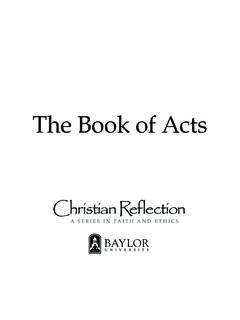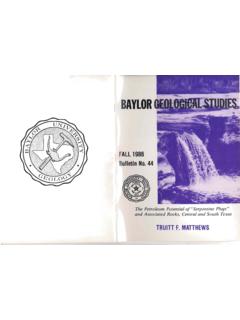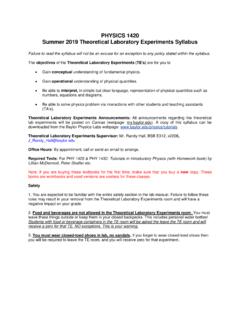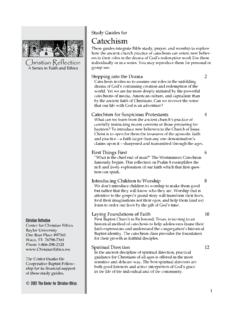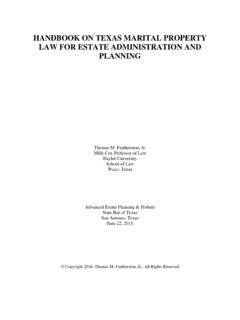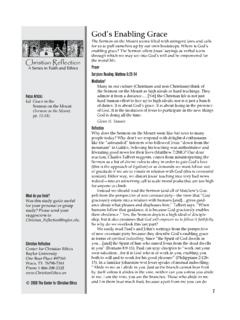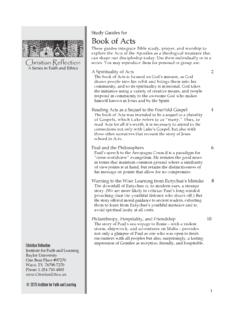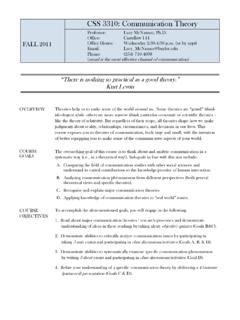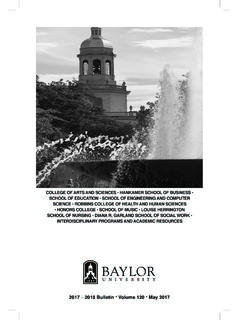Transcription of Study Guides for Women in the Bible
1 1 Christian ReflectionA Series in Faith and EthicsChristian ReflectionCenter for Christian EthicsBaylor UniversityOne Bear Place #97361 Waco, TX 76798-7361 Phone 1-866-298-2325 Center thanks the Cooperative Baptist Fellow-ship for its financial support of these Study Guides . 2013 The Center for Christian EthicsStudy Guides forWomen in the BibleThese Guides integrate Bible Study , prayer, and worship to explore the stories of Women in Scripture. Use them individually or in a series. You may reproduce them for personal or group Women in the Grand Narrative of Scripture 2In light of the biblical grand narrative of redemption and restorative justice, patriarchy and androcentrism can no longer be seen as normative, but as regrettable conditions that God and God s human agents are working to overcome.
2 Understanding so-called difficult passages in the light of the grand narrative begins to dissolve and relativize the problems in these is Mary Magdalene? 4 The traditional image of the Magdalene as a repentant prostitute, not to mention contemporary speculations about her being a priestess or goddess figure or bride of Christ, are quite mistaken. They fail to do justice to the biblical and historical woman behind the s Roles in the Letters to Timothy and Titus 6 The letters to Timothy and Titus reveal a growing con-sciousness about reputation in early Christian communities. Behavior that outsiders might find distasteful especially the behavior of Women could be perceived as immoral, compro-mising the honor of the group. How do these observations (and prescriptions) bear on the present?
3 Deborah s Daughters 8As prophetess and judge, Deborah became a potent symbol of female authority and speech, an obvious exemplar for Women aspiring to claim a public vote in the nineteenth century. Here are Women preachers, devotional writers, suffragists, and abolitionists who were Deborah s with Icons 10In the Orthodox tradition, icons like the saints and stories they portray point to the power of the larger story of Scripture, and show how great a God is our God. The photographs in the Women with Icons project reveal how the icons of patron saints, and the Women who hold them close, point to do you think?Was this Study guide useful for your personal or group Study ? Please send your suggestions to ReflectionCenter for Christian EthicsBaylor UniversityOne Bear Place #97361 Waco, TX 76798-7361 Phone 1-866-298-2325 2013 The Center for Christian EthicsFocus Article: Redeeming Women in the Grand Narrative of Scripture( Women in the Bible , pp.)
4 11-22)Suggested Articles: Rebekah s Scheme ( Women in the Bible , pp. 54-55) Judith s Co-conspirator ( Women in the Bible , pp. 56-58)Christian ReflectionA Series in Faith and EthicsRedeeming Women in the Grand Narrative of Scripture In light of the biblical grand narrative of redemption and restorative justice, patriarchy and androcentrism can no longer be seen as normative, but as regrettable conditions that God and God s human agents are working to overcome. Understanding Scripture s so-called difficult passages in the light of the grand narrative begins to dissolve and relativize the problems in these PrayerGod of creation, we know that we are made in your image, male and female. Yet, too often we have failed to honor the dignity of one have confined ourselves by holding one another to small roles and identities, based on gender.
5 We have disrespected one other; we have labeled and treated one another as have not honored the mystery of those who are different from us. We have closed our minds and our hearts to one us and help us, Lord, we pray. Readings: Genesis 1:26-27 and 1 Corinthians 11:2-16 ReflectionFor some readers today the Bible has lost its authority, Junia Pokrifka admits, because it seems to them to be written by men, about men, and for men. Women are only at the periphery of many of its stories, and sometimes are denigrated. But these readers are missing something that is important what feminist theologian Letty Russell once called the Bible s overarching story of God s love affair with the world. They fail to see this proverbial forest of love as they Study some of its trees in isolation.
6 And that is why Pokrifka urges us to read the Bible the other way around, interpreting its parts in terms of the whole story. She believes a grand narrative approach can help us to understand the Bible as authoritative and redemptive for both Women and men. The biblical narrative has three stages a beginning (Genesis 1-11), middle (the rest of the Old Testament), and end or perhaps the beginning of the end (the New Testament). Each stage, Pokrifka continues, is marked by three parallel themes: creation or inaugurated new creation (or partial redemption), rebellion and its consequences, and the promise or hope of complete new creation (full redemption). In turn, each theme includes three elements the image of God, procreation or fruitfulness, and dominion that particularly concern the identity and destiny of Women in God s purposes.
7 Let s see how Pokrifka employs this grand narrative to interpret a difficult text the Apostle Paul s concern about Women teaching without a head covering (1 Corinthians 11:2-16). Paul uses creational details to frame his instructions to both men (v. 7) and Women (v. 10) teachers. Here s the difficulty : does verse 7bc contradict Genesis 1:27 and promote male superiority, as many have insisted? Pokrifka notes that Paul appeals to nature rather than God s created order to affirm different hairstyles for men and 3 Christian ReflectionA Series in Faith and EthicsRobert B. Kruschwitz, the author of this Study guide, directs the Center for Christian Ethics at Baylor University. He serves as General Editor of Christian Reflection. 2013 The Center for Christian Ethicswomen (vv.)
8 14-15). Women , according to Genesis 1-2, are as much the image and glory of God as men; so, Paul s suppressing this fact must be rhetorical, a way of supporting his point that Christian men and Women should embrace different, culturally acceptable hairstyles. His teaching that woman is the glory of man (v. 7c) is not a new revelation, but a rabbinic interpretation from Genesis 2:20-23 that points to the woman s exalted status as the crown, or completion, of humankind. Paul highlights the female teachers authority when he says the woman ought to have authority over her head (v. 10), that is, the man (v. 3). Pokrifka translates Paul s main biblical reason for Women s authority this way: neither was man created because of woman, but woman because of man (v.
9 9). When the man was incomplete without a helper, the woman was created with equal authority to serve and guard the Garden (Genesis 2). In a cultural context that otherwise suppressed Women s voice, Paul is appealing to the creational story to encourage the Women of Corinth to reclaim their creational authority to pray and prophesy freely, not only over Women , but also over men, Pokrifka suggests. Yet in order to avoid any overestimation or misapplication of the authority of Women , Paul then reinforces the interdependence, mutuality, and complementarity of men and Women and their ultimate dependence on God (vv. 11-12). Through the Bible s grand narrative we can see that God s intention from the beginning has been to bring both Women and men into the fullness of life as those created in the image God and invested with resultant dignity and responsibility, Pokrifka concludes.
10 Those who are redeemed are ultimately not bound to live within the limits of any sinful social order, including patriarchy. Yet, as Paul s teaching here reminds us, our freedom must be used in godly, loving dependence on God and interdependence with other members of Christ. Before the day of God s consummated kingdom, God calls us to exercise self-giving love that is patient with others who, like us, are in process. Study Questions1. How do the three themes creation/inaugurated new creation, rebellion, and promise/hope of complete new creation shape each stage of the biblical narrative?2. How do the three elements the image of God, procreation or fruitfulness, and dominion particularly concern the identity and destiny of Women in God s purposes?3. Why does it make hermeneutical good sense to let the grand narrative and Women s place within it limit and guide our interpretation of so-called problem texts (like 1 Corinthians 11:2-16) rather than the other way around?
